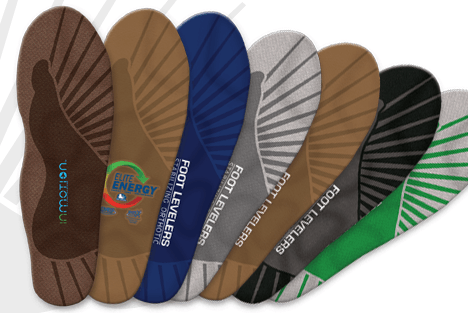Our feet are charged with supporting our entire bodies, maintaining our balance, and acting as shock absorbers. They are under constant strain: even a gentle stroll causes stress to the feet, particularly the arches. And because our arches can wear down overtime, this stress can lead to pain in other regions of the body as well as in the feet.

Fallen arches can affect your entire body. (image courtesy of Footlevelers.com)
What we call the arch of the foot is actually three arches made up of the bones of the feet. Ligaments and tendons made of semi-flexible fibers connect these bones. The fibers bend and stretch as we walk, but, unlike other more flexible fibers in the body, they are less elastic and more plastic (rigid). Consider the difference between a rubber band and a piece of taffy. If you stretch out a rubber band, it will snap back to its original shape. But if you pull on a piece of hard taffy, the taffy will just stretch. It will regain some of its original shape, but as you continue pulling it, the taffy will begin to lengthen until it wears thin and loses its shape: once you stretch a piece of taffy, it will never be the same again.
The arches of your feet are like taffy. Normal use slowly breaks down the fibers in the arches until they can no longer support the rest of the foot. The arches collapse, causing overpronation of the foot which pulls on the fascia of the bottoms of the feet and can lead to plantar fasciitis as well as pain in the ankles, Achilles tendon, and the inside of the knee. Fallen arches can also cause or contribute to lower back pain and lateral hip pain.
Fallen arches occur more often over the age of forty and in women. While they can occur through normal wear and tear, a fall or regular participation in high-impact sports can increase the likelihood of damage to the arches. In addition, obesity, diabetes, high blood pressure, and steroid injections may contribute to the degradation of the arch. Your genes can play a role in the development of fallen arches or flat feet as well. For example, if your mother or father had dropped arches or flat feet, you may as well.
The good news is that you can do something about it. Orthotics can provide support when your arch collapses, preventing plantar fasciitis, heel spurs, Achilles tendonitis, and ankle pain from developing. If you are already suffering from arch-related issues, orthotics can lessen the pain and correct the strain on your feet and bring that spring back into your step.

Our office recommends non-custom Superfeet (priced at $36-$46) and custom orthotics made from your own imprint by Footlevelers.

